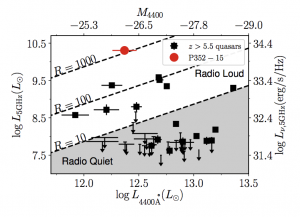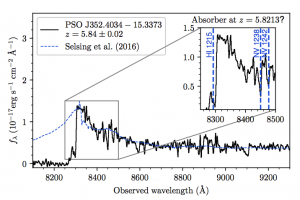Editor’s note: Astrobites is a graduate-student-run organization that digests astrophysical literature for undergraduate students. As part of the partnership between the AAS and astrobites, we occasionally repost astrobites content here at AAS Nova. We hope you enjoy this post from astrobites; the original can be viewed at astrobites.org!
Title: A Powerful Radio-Loud Quasar at the end of Cosmic Reionization
Authors: Eduardo Banados, Chris Carilli, Fabian Walter, et al.
First Author’s Institution: The Observatories of the Carnegie Institution for Science
Status: Published in ApJL
Quasars are some of the most interesting astronomical objects, able to provide us with information across both astrophysics and cosmology. When a quasar with unique properties — such as being exceptionally luminous — is discovered, it’s particularly eye-catching. This is because it can provide an opportunity to make measurements that wouldn’t be possible otherwise, as we will explore in today’s astrobite.
What’s All the Fuss About Quasars?
Astronomers look to quasars because of the extreme conditions surrounding their existence. They are exceptionally bright and emit across the entire span of the electromagnetic spectrum — luminous emissions that are thought to be due to the accretion of gas onto a supermassive black hole at the center. You might be asking yourself: if these are so bright, why do we even need telescopes to see them? Most quasars are at incredible distances, located at redshifts of z > 0.1 — meaning relative to anything local to us, they’ll appear very dim. In fact, the closest quasar to us, Markarian 231, is still at a measurable redshift of z = 0.04.

Figure 1: Flux density of a quasar’s emission across observed wavelengths. The rapidly varying peaks from ~4300 to 4900 Angstroms is known as the Lyman-alpha forest, where dips correspond to neutral hydrogen that has absorbed Lyman-alpha photons. [http://www.aip.de/groups/cosmology/im.html]
Cosmic Reionization
The Epoch of Reionization (EoR) is a period in cosmic history when neutral hydrogen from the early universe became reionized. This was due to the earliest stars and galaxies generating an abundance of ionizing UV radiation which systematically reionzied the surrounding hydrogen beginning somewhere around a redshift of z ~ 12 (300 Myr after the Big Bang). This process, based on our best “guess”, has reionization completing somewhere in the region of redshift z ~ 6. Having a rough idea when the EoR ended gives us a great starting point to begin searching for additional evidence of the reionization process. Thus why we are very excited about discovering quasars at very high redshift, because they can directly probe the amount of neutral hydrogen present in the IGM.
Radio-Brightest Quasar To Date

Figure 2: The relative log luminosities of quasars at 4,000 Angstroms to radio emissions at 5GHz. This shows that the quasar P352–15 is radio-brightest of all competing high-redshift quasars. [Banados et al. 2018]

Figure 3: Flux density measurement over observed wavelengths of the quasar PSO J352.4034-15.3373. A sharp drop-off at a wavelength of ~8300 Angstroms indicates that between us and the quasar is a very dense lyman alpha absorbing environment. [Banados et al. 2018]
Going beyond cosmological implications, the authors additionally point to future potential studies for PSO J352–15 that could include radio-jet measurements to understand how supermassive black holes form, and how important radio-mode feedback is to the earliest galaxies. To see additional information on PSO J352-15 you can check out the companion paper, which goes into the components and morphology of the quasar.
About the author, Joshua Kerrigan:
I’m a 5th year PhD student at Brown University studying the early universe through the 21cm neutral hydrogen emission. I do this by using radio interferometer arrays such as the Precision Array for Probing the Epoch of Reionization (PAPER) and the Hydrogen Epoch of Reionization Array (HERA).
